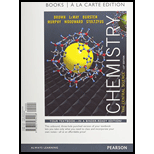
Chemistry: The Central Science, Books a la Carte Edition & Modified Mastering Chemistry with Pearson eText -- ValuePack Access Card Package
1st Edition
ISBN: 9780133910919
Author: Theodore E. Brown, H. Eugene LeMay, Bruce E. Bursten, Catherine Murphy, Patrick Woodward, Matthew E. Stoltzfus
Publisher: PEARSON
expand_more
expand_more
format_list_bulleted
Concept explainers
Textbook Question
Chapter 21, Problem 67E
Aerosols are important components of the atmosphere. Does the presence of aerosols in the atmosphere increase or decrease the amount of sunlight that arrives at the Earth’s surface, compared to an “aerosol-free” atmosphere? Explain your reasoning.
Expert Solution & Answer
Want to see the full answer?
Check out a sample textbook solution
Students have asked these similar questions
Pls help me on this q.
Given the elementary reactions in an aqueous medium with an ionic strength of 0.001:1) CH3Br + OH- → CH3OH + Br-2) ClCH2COO- + OH- → HOCH2COO- + Cl-3) [Co(NH3)5Br]2+ + NO2- →[Co(NH3)5NO2]2+ + Br-If the ionic strength is decreased, 1) k will not change; 2) k will decrease; and 3) k will increase. Is this correct?
Relate zero ionic strength and infinite dilution limit.
Chapter 21 Solutions
Chemistry: The Central Science, Books a la Carte Edition & Modified Mastering Chemistry with Pearson eText -- ValuePack Access Card Package
Ch. 21.1 - Prob. 21.1.1PECh. 21.1 - Prob. 21.1.2PECh. 21.1 - Prob. 21.2.1PECh. 21.1 - Prob. 21.2.2PECh. 21.2 - Which aqueous solution will have the lowest...Ch. 21.2 - Prob. 21.3.2PECh. 21.3 - Prob. 21.4.1PECh. 21.3 - Prob. 21.4.2PECh. 21.4 - Prob. 21.5.1PECh. 21.4 - Practice Exercise 2
Camphor (C10 H16 O) melts at...
Ch. 21.4 - Prob. 21.6.1PECh. 21.4 - Prob. 21.6.2PECh. 21.4 - Prob. 21.7.1PECh. 21.4 - Rank the contents of the following containers in...Ch. 21.6 - Prob. 21.8.1PECh. 21.6 - Consider two ionic solids, both composed of singly...Ch. 21 - Prob. 1DECh. 21 - Would you expect stearic acid, CH3 (CH2)16COOH, to...Ch. 21 - 13.43 Calculate the morality of the following...Ch. 21 - Commercial aqueous nitric acid has a density of...Ch. 21 - Prob. 4ECh. 21 - Prob. 5ECh. 21 - Prob. 6ECh. 21 - Prob. 7ECh. 21 - If the experiment in Figure 14.2 is run for 60 s,...Ch. 21 - Prob. 9ECh. 21 - Indicate the principal type of solute-solvent...Ch. 21 - When ammonium chloride dissolves in water, the...Ch. 21 - Prob. 12ECh. 21 - KBr is relatively soluble in water, yet its...Ch. 21 - The solubility of MnSO4 . H2 O in water at 20 C is...Ch. 21 - Prob. 15ECh. 21 - Prob. 16ECh. 21 - Prob. 17ECh. 21 - Prob. 18ECh. 21 - Prob. 19ECh. 21 - Prob. 20ECh. 21 - Prob. 21ECh. 21 - Indicate whether each statement is true or false:...Ch. 21 - 13.36 Indicate whether each statement is true or...Ch. 21 - Prob. 24ECh. 21 - Prob. 25ECh. 21 - Prob. 26ECh. 21 - Prob. 27ECh. 21 - Prob. 28ECh. 21 - Prob. 29ECh. 21 - Calculate the molality of each of the following...Ch. 21 - (a) What is the molality of a solution formed by...Ch. 21 - Prob. 32ECh. 21 - Prob. 33ECh. 21 - Prob. 34ECh. 21 - The density of toluene (C7H8) is 0.867 g\mL, and...Ch. 21 - Calculate the number of moles of solute present in...Ch. 21 - Prob. 37ECh. 21 - Prob. 38ECh. 21 - Describe how you would prepare each of the...Ch. 21 - Prob. 40ECh. 21 - Prob. 41ECh. 21 - Prob. 42ECh. 21 - Prob. 43ECh. 21 - Prob. 44ECh. 21 - Prob. 45ECh. 21 - Prob. 46ECh. 21 - Prob. 47ECh. 21 - Prob. 48ECh. 21 - (a) Calculate the vapor pressure of water above a...Ch. 21 - Prob. 50ECh. 21 - Prob. 51ECh. 21 - Prob. 52ECh. 21 - Prob. 53ECh. 21 - Using data from Table 13.3, calculate the freezing...Ch. 21 - Prob. 55ECh. 21 - Prob. 56ECh. 21 - Prob. 57ECh. 21 - Prob. 58ECh. 21 - Prob. 59ECh. 21 - Prob. 60ECh. 21 - Prob. 61ECh. 21 - The osmotic pressure of a 0.010 M aqueous solution...Ch. 21 - Prob. 63ECh. 21 - (a) Do colloids made only of gases exist? Why or...Ch. 21 - Prob. 65ECh. 21 - An “emulsifying agent” is a compound that helps...Ch. 21 - Aerosols are important components of the...Ch. 21 - Prob. 68ECh. 21 - Soaps consist of compounds such as sodium state,...Ch. 21 - Most fish need at least 4 ppm dissolved O2 in...Ch. 21 - The presence of the radioactive gas radon (Rn) in...Ch. 21 - Prob. 72AECh. 21 - Prob. 73AECh. 21 - The maximum allowable concentration of lead in...Ch. 21 - Prob. 75AECh. 21 - Prob. 76AECh. 21 - Prob. 77AECh. 21 - Prob. 78AECh. 21 - The normal boiling point of ethanol, is 78.4 0C....Ch. 21 - Prob. 80AECh. 21 - Prob. 81AECh. 21 - Prob. 82AECh. 21 - Prob. 83AECh. 21 - Prob. 84AECh. 21 - Prob. 85AECh. 21 - Prob. 86AECh. 21 - Prob. 87AECh. 21 - Prob. 88AECh. 21 - Prob. 89IECh. 21 - Prob. 90IECh. 21 - Prob. 91IECh. 21 - Prob. 92IECh. 21 - Prob. 93IECh. 21 - Prob. 94IE
Knowledge Booster
Learn more about
Need a deep-dive on the concept behind this application? Look no further. Learn more about this topic, chemistry and related others by exploring similar questions and additional content below.Similar questions
- The photolysis of H3C–N=N–C2H5 involves the breaking of the single bonds shown. According to this, in addition to N2, what products would be obtained primarily if the reaction were carried out in the gas phase or in solution in an inert solvent?arrow_forwardGiven a keto-enol tautomerization reaction, which is greatly influenced by the type of solvent, indicate which of the following solvent properties cannot be considered a "solvent effect"?(A) Dielectric constant(B) Polarity(C) Hydrogen bonding capacity(D) Temperaturearrow_forwardIn solution reactions, what does "solvent effect" mean?arrow_forward
- How to solvearrow_forwardIndicate the concentration and ionic strength ranges to which the Debye-Huckel equation can be applied. And the Davies equation?arrow_forwardIf the ionic strength (I) of a solution is very low, the Debye-Huckel equation is used. If I is higher, the Davies equation is used. What is the correct value for I to use one or the other?arrow_forward
- In both the Debye-Huckel equation and the Davies equation, there is a constant A. I see that sometimes it appears as 0.51 and other times as 1.02. Explain why one or the other value is used.arrow_forwardThe two equations are forms of the Davies equation, used in thermodynamics for activity coefficients: ال log Y₁ = -Az² - 0,31 log = Az² - 0,31 1 + √Ĩ 1 + √√ k These equations are consistent and imply that Yi = Is this last equation correct? karrow_forwardThe two equations are forms of the Davies equation, used in thermodynamics for activity coefficients: ال log Y₁ = -Az² - 0,31 log = Az² - 0,31 1 + √Ĩ 1 + √√ k These equations are consistent and imply that Yi = Is this last equation correct? karrow_forward
- For the Davies equation, both expressions are correct: log Y₁ = -Az² √i - 0,31 1 + √ k log- = Az - 0,31 k 1 + √Ĩarrow_forwardk In Davies' equation log y₁ = log- log y₁ = log | = -Az² + ✓// k A is a constant that always equals 1.02. Correct? - 0,31arrow_forwardIndicate whether the equality is true Yi How is it obtained? k%arrow_forward
arrow_back_ios
SEE MORE QUESTIONS
arrow_forward_ios
Recommended textbooks for you
 Chemistry: The Molecular ScienceChemistryISBN:9781285199047Author:John W. Moore, Conrad L. StanitskiPublisher:Cengage Learning
Chemistry: The Molecular ScienceChemistryISBN:9781285199047Author:John W. Moore, Conrad L. StanitskiPublisher:Cengage Learning Chemistry for Engineering StudentsChemistryISBN:9781337398909Author:Lawrence S. Brown, Tom HolmePublisher:Cengage Learning
Chemistry for Engineering StudentsChemistryISBN:9781337398909Author:Lawrence S. Brown, Tom HolmePublisher:Cengage Learning

Chemistry: The Molecular Science
Chemistry
ISBN:9781285199047
Author:John W. Moore, Conrad L. Stanitski
Publisher:Cengage Learning

Chemistry for Engineering Students
Chemistry
ISBN:9781337398909
Author:Lawrence S. Brown, Tom Holme
Publisher:Cengage Learning
Solutions: Crash Course Chemistry #27; Author: Crash Course;https://www.youtube.com/watch?v=9h2f1Bjr0p4;License: Standard YouTube License, CC-BY